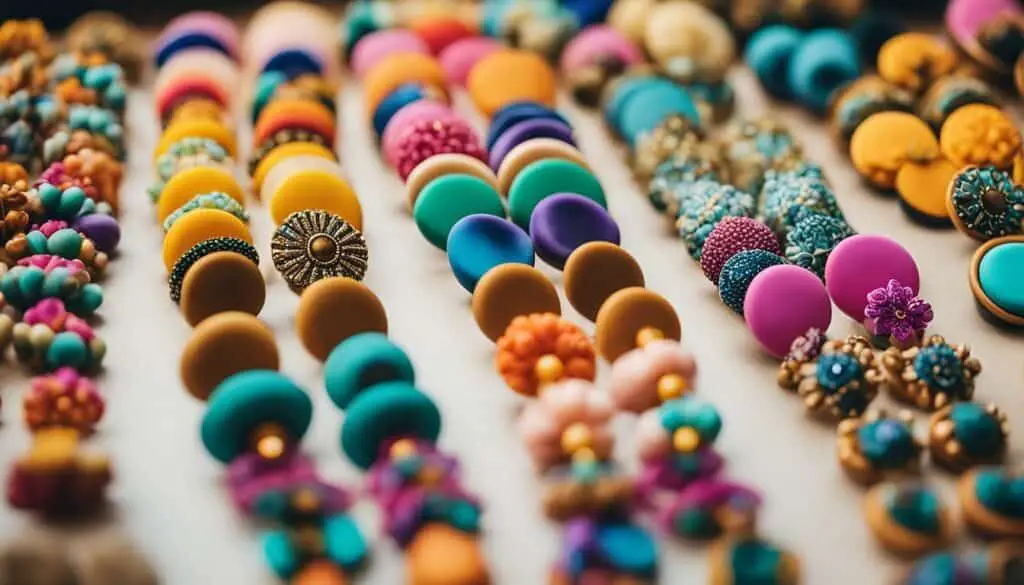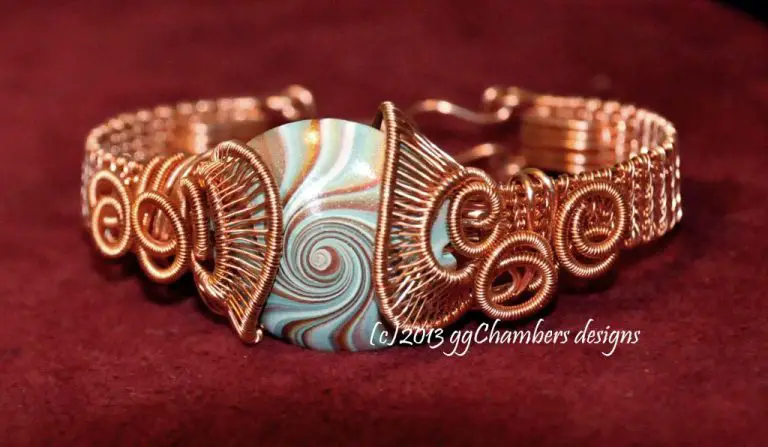What Is Clay Jewelry Made Of?
What is Clay?
Clay is a naturally occurring mineral substance that is plastic when wet but hard when fired. Clay is composed mainly of fine-grained minerals such as illite, kaolinite, and montmorillonite. When mixed with water, clay becomes flexible and can be shaped or molded.
The two main types of clay used for making jewelry are polymer clay and ceramic clay:
- Polymer clay is made from PVC resin and plasticizers. Popular brands used for jewelry making include Fimo, Sculpey, and Premo. Polymer clay remains flexible after hardening and does not require firing.
- Ceramic clay is natural clay from the earth that is molded and then fired in a kiln to harden it. Varieties used for jewelry include earthenware, stoneware, and porcelain.
Clays come in a range of colors that can be blended and mixed to create unique hues and patterns. Clays are popular for jewelry making because they can be hand shaped, molded, rolled, and cut into detailed designs.
History of Clay Jewelry
The history of clay jewelry dates back thousands of years. Archaeological evidence shows that clay was one of the first materials used to create jewelry and ornamental objects. Some of the earliest known clay jewelry and figurines come from ancient Mesopotamia. Excavations at sites like Ur and Uruk, dating back to 4000-3500 BCE, have uncovered terracotta beads, pendants, and small statues [1].
Ancient Egyptians also produced clay jewelry and amulets, such as the popular scarab beetle amulets found in tombs dating from 3500-1500 BCE [2]. The ancient Indus Valley civilization, existing from 2500-1900 BCE in modern Pakistan and northwest India, produced intricate terracotta bangles, beads, and figurines depicting humans and animals [2].
In ancient Greece, terracotta jewelry and figurines became closely tied with religion and ritual. Greeks often buried terracotta amulets and charms with deceased loved ones. Throughout ancient history, clay jewelry remained accessible to all classes, unlike precious materials reserved for elites.
Clay Jewelry Making Process
Making clay jewelry involves several key steps. The basic process is:
- Prepare the clay by conditioning it to make it soft and pliable. This involves kneading and rolling the clay.
- Shape the clay pieces using hands and/or clay tools like rollers, cutters, molds, etc. Pieces can be hand sculpted or molded.
- Attach any embellishments like beads, charms, glitter, etc. These can be pressed into the soft clay.
- Bake the clay according to package directions to harden it. Baking temp and times vary.
- After baking, allow pieces to cool completely before handling.
- Sand and buff pieces to smooth edges and create sheen.
- Apply liquid clay, glazes, etc for color and effects if desired.
- Bake again if required to set liquid clay or glazes.
- Assemble pieces by attaching findings, jump rings, ear wires, etc using jewelry pliers.
Key tools for working with polymer clay include acrylic roller, cutters, molding tools, texturing items, and various jewelry pliers for assembly. Sharp sculpting tools are good for detailing. Proper conditioning and baking are essential for strong finished pieces. With practice, clay can be crafted into an endless array of jewelry designs (https://sarahmaker.com/polymer-clay-earrings/).
Types of Clay Jewelry
Clay can be molded into a variety of jewelry pieces including beads, pendants, rings, earrings, and more. Some of the most common types of clay jewelry include:
Beads – Clay beads are extremely versatile and can be used to create necklaces, bracelets, earrings, and more. Polymer clay beads are lightweight and come in endless shape, size, and color options.
Pendants – Intricate pendants made from polymer or air-dry clay allow jewelry makers to get creative with detailed designs. Pendants can be made using molds or hand-sculpted.
Rings – Rings are formed by hand or using ring blanks made of clay. A clay ring can showcase a decorative focal bead or an intricate patterned clay band.
Earrings – Lightweight clay is an ideal material for earrings, making large statement pieces comfortable to wear. Clay earrings may feature dangling pendants, sculptural shapes, or simple studs.
Clay can also be used to fabricate jewelry components like clasps, beads spacers, and decorative elements. The possibilities are endless with all the flexibility clay provides.https://www.firemountaingems.com/resources/jewelry-making-articles/cb7m
Clay Jewelry Styles
Clay jewelry comes in a diverse array of styles, drawing inspiration from cultures around the world as well as contemporary designs. Many clay artisans take motifs from Native American, African, and Asian artistic traditions and incorporate them into their jewelry. For example, Navajo-inspired clay jewelry often features geometric shapes and earthy tones of turquoise, red, and brown[1].

Contemporary clay jewelry embraces minimalist, modernist, and abstract looks. Large, chunky statement pieces in solid blocks of color are trendy[2]. Delicate wirework and filigree clay details create an intricate, lacy effect. Some artisans sculpt intricate figurines like animals or flowers to adorn their jewelry. The versatility of polymer and metal clays means jewelers can shape diverse, creative designs from functional wearable art to whimsical charms.
Clay Jewelry Finishing
Finishing is a crucial step in creating beautiful and durable clay jewelry. After baking the clay, there are several techniques that can be used to finish the piece.
Glazing involves applying a liquid polymer clay glaze and rebaking the piece. Glazes come in various finishes like gloss, satin, and matte. Glazing helps smooth the clay surface, hide fingerprints and other imperfections, and add a protective coat. It’s important to carefully follow the manufacturer’s instructions for applying and rebaking glazes (source).
Painting clay jewelry is another popular finishing technique. Acrylic paints formulated for clay work best. Paint can be used to add color and designs or antique the clay. The paint should be sealed with a finish like glaze or varnish after drying (source).
Sealing the clay protects it from moisture and helps prevent color transfer. Polymer clay sealing options include glaze, acrylic spray sealants, beeswax polish, and epoxy resin. Multiple coats are often needed for good protection. It’s best to avoid water-based finishes like decoupage medium because they can make baked clay soft again.
Wearing and Caring for Clay Jewelry
Clay jewelry is lightweight and comfortable to wear. However, there are some tips for properly wearing and caring for your clay jewelry to help it last longer.
When wearing clay earrings, avoid pulling on them forcefully or letting them get tangled in hair or clothing. Clay can be flexible, but it’s best not to bend the jewelry repeatedly to prevent cracks or breaks. Polymer clay in particular can become brittle over time.1
To clean clay jewelry, use a slightly damp, non-abrasive cloth to gently wipe away dirt or oils. Avoid submerging clay jewelry in water. Do not use acetone, alcohol, or other harsh chemicals to clean clay as this can damage the material.23
Proper storage is also important for keeping clay jewelry looking its best. Store pieces in a clean, dry place away from direct sunlight and heat. Keep them in separate boxes or pouches to prevent scratches. Storing clay jewelry properly will help prevent cracking, chipping, and fading of colors over time.
Clay Jewelry Artists
Clay jewelry has grown in popularity thanks to talented artists who have pushed the boundaries of the medium. Some notable clay jewelers known for their innovative designs and techniques include:
Donna Kato – Kato is considered one of the pioneers of polymer clay jewelry. She is known for her highly textured and layered pendant designs often incorporating glass beads, gold leaf, and other mixed media.
Lisa Pavelka – An internationally renowned polymer clay artist, Pavelka creates colorful jewelry and home decor items. She is known for developing innovative techniques like double skeins and faux cloisonne.
Bori Gheorghita – A Romanian jewelry artist, Gheorghita’s nature-inspired polymer clay designs feature delicate details like feathers, flowers, and butterflies. Her work has an ethereal, romantic style.
Clay jewelry artists continue to find new ways to manipulate and blend clays to achieve stunning visual effects. Their creativity and mastery of the medium has helped grow the popularity of clay jewelry worldwide.
Cost of Clay Jewelry
The cost of clay jewelry can vary greatly depending on the materials used, the complexity of the design, and whether it was handmade by an artisan or mass-produced. According to Etsy, clay jewelry prices typically range from $5 to $20 for simpler earrings and pendants up to $150 or more for elaborate statement pieces (Source). Handmade polymer clay earrings on Etsy tend to cost $15 to $30, while necklaces range from $20 to $60.
Factors that affect the price of clay jewelry include:
- Type of clay – Polymer clay is more expensive than air-dry clay.
- Use of other materials like gemstones, metal findings or beads – These add to the cost.
- Complexity and size of the design – More intricate, layered pieces take more time and skill to create.
- Brand name or designer – Work from an established artist commands higher prices.
- Whether the piece is handmade or mass-produced – Unique handmade pieces cost more than manufactured jewelry.
- Labor involved – Intricate hand-sculpted designs require more time and effort.
In summary, simple clay jewelry and mass-produced pieces tend to range from $5 to $30, while elaborate handmade artisan designs can cost $50 to $150 or even more.
Popularity of Clay Jewelry
Clay jewelry has been growing in popularity in recent years, especially polymer clay jewelry. According to Spring 2023 Jewelry Trends – Interweave, clay jewelry continues to be a major trend going into 2023. Polymer clay, in particular, is loved for its lightweight, malleable properties that allow creators to make colorful, detailed statement pieces.
There are several benefits of polymer clay jewelry over other materials that contribute to its popularity:
- It’s very lightweight, making large statement pieces comfortable to wear.
- The malleability of polymer clay allows for intricate, customizable designs not possible with other materials.
- A wide variety of colors are available to create any look.
- It’s affordable, especially compared to precious metals and gemstones.
- Polymer clay is easy to work with for beginners but also allows for advanced techniques.
Handmade polymer clay jewelry has become a huge sector on sites like Etsy where creators make everything from earrings to necklaces and rings. Its versatility and individuality make it a popular choice for artisan jewelry.

